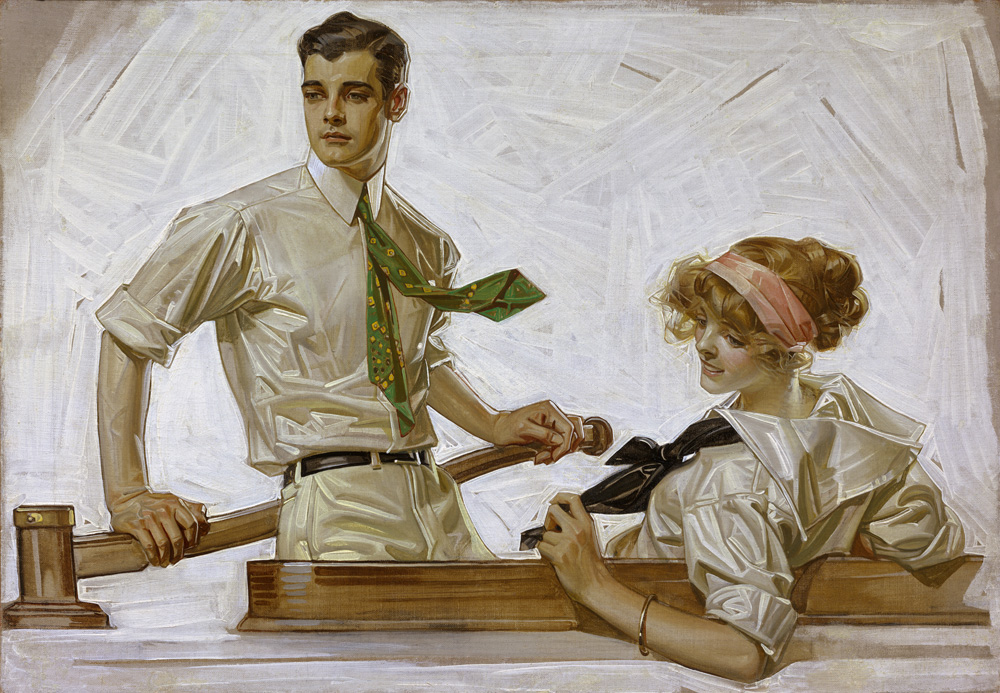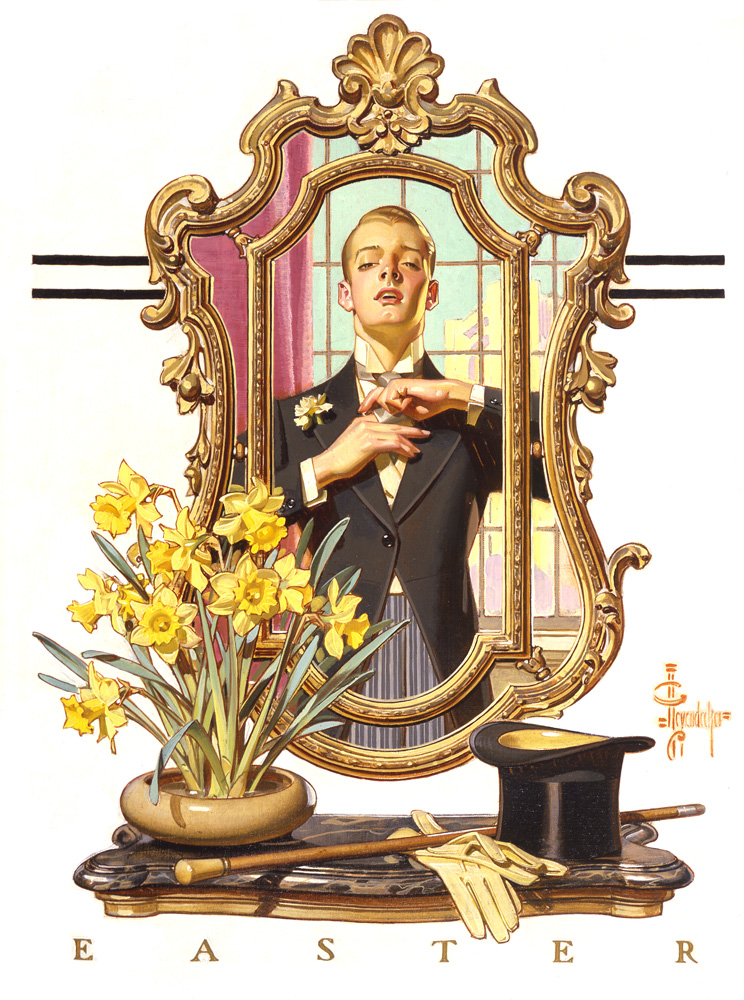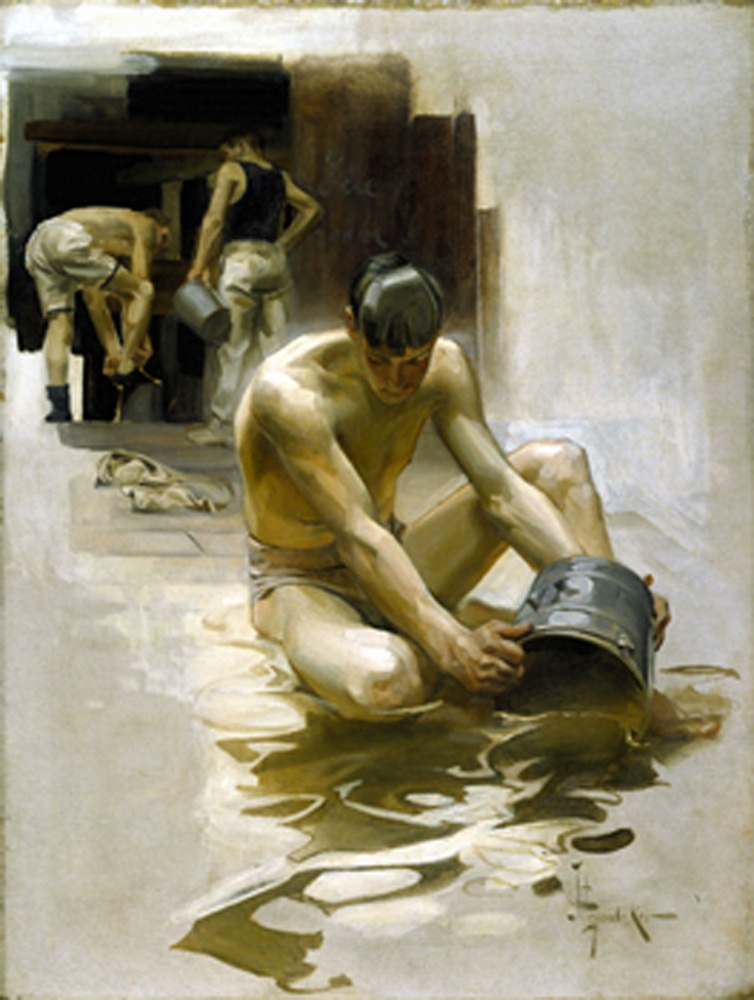- youtube
- bluesky
- Home
- About
- Costume Journal
- Membership
- Conference & Events
- Grants & Awards
- News & Social
In this week’s blog, Costume Society News Editor Babette Radclyffe-Thomas reviews the Under Cover: J.C. Leyendecker and American Masculinity exhibition which opened May 5th at the New York Historical Society, New York.
Illustrator and commercial artist J. C. Leyendecker’s (1874-1951) era-defining work is currently on show at the New York Historical Society. Emblematic of American visual culture from the start of the 20th century to the 1930s, Leyendecker’s advertising campaigns such as ‘Arrow Collar Man’ and covers for the Saturday Evening Post and Collier’s have become iconic depictions of masculinities.
“J.C. Leyendecker was an amazingly talented artist whose illustrations have come to embody the look and feel of the first half of the century while simultaneously demonstrating how fluidity in gender expression and gay representation were actually quite common at the time, contrary to current assertions that they are unique to our own moment,” shares Donald Albrecht, guest curator. “Not only did his work exemplify the zeitgeist, but it depicts a deeply nuanced view of sexuality and advertising that broadens our understanding of American culture.”
Leyendecker’s work typified the era’s shifting definitions of masculinity, so much so that in 1913 New York’s Sun newspaper declared him the ‘champion’ of men in art and President Theodore Roosevelt viewed his illustrations as a “superb example of the common man.”
A gay artist, Leyendecker’s work often had homoerotic undertones and was produced for a mainstream wide audience. “Under Cover: J.C. Leyendecker and American Masculinity deepens our understanding of the struggle for full civil rights as Americans of the LGBTQ+ community. The exhibition is part of New-York Historical’s ongoing commitment to tell stories of Americans whose lived experience, though important and consequential to our history, is so often absent from textbooks in schools and colleges,” Dr Louise Mirrer, President and CEO of New-York Historical said.
The exhibition is hosted in one room separated into two sections. The first section focuses on Leyendecker’s depictions of the male body, and the second has a focus on images of male intimacies. “By reviewing all the available paintings, I decided to organize the show into two parts: the masculine physique and masculine interactions. These themes informed my selection,” Albrecht said. In total 19 works are showcased in the space, including the artist’s original oil paintings, editorial work such as magazine covers, commercial illustrations that appeared across the country on billboards and on mass transit.
Leyendecker created advertisement illustrations for a wide array of brands such as Gillette razors, Interwoven socks and House of Kuppenheimer menswear. His distinctive aesthetic vision saw functional, practical items becoming objects of desire under his gaze. A new mode of advertisement via emotion and narration rather than a detailed description of a product’s benefits.
Clothing was central to Leyendecker’s work, from college jumper clad muscular young men to his men about town kitted out in sharp tailoring. “Like today, clothing and fashion were important markers of class in consumer culture,” Albrecht shares. Leyendecker’s campaigns for Arrow collars were iconic. These depictions of men wearing shirts with detachable collars and cuffs created by Cluett, Peabody & Co that allowed wearers to clean and starch them separately created and celebrated the identity of the ‘Arrow Collar Man’. The image of masculinity here, as is common in other Leyendecker illustrations, is a young, white, handsome, and clean-shaven man.
Leyendecker’s portfolio was extensive: he created 322 cover illustrations for the Post. These suggestive and provocative images were often highly sexually charged depictions of male interactions. Leyendecker’s athletes embodied the philosophy of ‘muscular Christianity’ whose followers believed in male athleticism as a means towards moral and patriotic good. Beautiful men engage in activities such as golfing, boating, reading in men’s clubs. Interestingly, the model used for much of Leyendecker’s work was his own lover and business partner, Charles Beach.
While Leyendecker created images of a wide array of masculinities such as the sailor, athlete, soldier and aesthete, his images still focused on a nationalist ideal image of the white, male athletic body. However, the exhibition includes artefacts such as images of Harlem Renaissance era African American men that counter this predominant vision. Context is also provided with a digital show of contemporary gay culture in New York as well as advertisements with distinctly homoerotic connotations.
Works on show are from the collection of the National Museum of American Illustration, Newport, RI and the exhibition is organised by New-York Historical. There are no plans for the exhibition to travel.
If Leyendecker's work has invoked an interest in fashion represented in illustration, read Babette's previous blog post on Gladys Perint Palmer.
Image gallery

J.C. Leyendecker (1874–1951) Couple in Boat Painting for Arrow Collar advertisement, 1912 Oil on canvas National Museum of American Illustration, Newport, RI

J.C. Leyendecker (1874–1951) Easter – Man in the Mirror Painting for cover of Saturday Evening Post, April 11, 1936 Oil on canvas National Museum of American Illustration, Newport, RI

J.C. Leyendecker (1874–1951) Ivory Soap It Floats Painting for Ivory soap advertisement, 1900 Gouache on board Private collection, Image courtesy of the National Museum of American Illustration, Newport, RI

J.C. Leyendecker (1874–1951) Thanksgiving: 1628-1928 (Pilgrim and Football Player) Painting for cover of Saturday Evening Post, November 24, 1928 Oil on canvas Private collection, Image courtesy of the National Museum of American Illustration, Newport, RI

J.C. Leyendecker (1874–1951) In the Yale Boathouse, 1905 Oil on canvas National Museum of American Illustration, Newport, RI